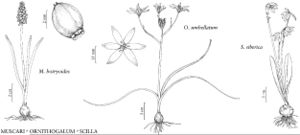Ornithogalum
Sp. Pl. 1: 306. 1753.
Gen. Pl. ed. 5, 145. 1754.
| Taxon | Illustrator ⠉ | |
|---|---|---|
 | Muscari botryoides Ornithogalum umbellatum Scilla siberica | Yevonn Wilson-Ramsey Yevonn Wilson-Ramsey Yevonn Wilson-Ramsey |
Herbs, perennial, scapose, poisonous, from ovoid, tunicate bulbs; bulb tunics white to pale-brown, papery. Leaves few to several, basal; blade linear to lanceolate, margins smooth or hairy. Inflorescences racemose or corymbose, 2–many-flowered, bracteate; bracts white, membranous. Flowers: tepals 6, widely spreading, distinct, equal to slightly unequal; stamens 6, distinct, dimorphic; filaments simple or 3-dentate, flattened; anthers dorsifixed, introrse; ovary superior, green, 3-locular, cylindric to globose, 6-angled, septal nectaries present; style 1; stigma margins entire or indistinctly 3-lobed. Fruits capsular, angled, papery, dehiscence loculicidal. Seeds numerous, globose to ovoid. x = 3, 5, 6, 7, 8, 9, 11.
Distribution
Introduced; Europe, Africa, w Asia
Discussion
Species 100–150 (2 in the flora).
Ornithogalum is a large genus centered in South Africa and around the Mediterranean, with numerous species of horticultural note. Ornithogalum pyrenaicum Linnaeus was apparently naturalized for a number of years at Elkins, West Virginia (E. E. Hutton and R. E. Clarkson 1961), but it is now extirpated from that site. Ornithogalum arabicum Linnaeus, Arabian star flower, O. caudatum Aiton, sea-onion, and O. thyrsoides Jacquin, chincherinchee, are frequently cultivated in the warmer parts of the flora area.
The bulbs of Ornithogalum species are poisonous due to the presence of a variety of cardiotoxic cardenolides (G. E. Burrows and R. J. Tyrl 2001), and the bulbs should not be confused with those of wild onions.
Selected References
None.
Lower Taxa
Key
| 1 | Leaves 5–10 mm wide; inflorescences racemose, cylindrical, 5–12(–18)-flowered; lower pedicels to 1 cm; flowers nodding, especially after anthesis; filaments 3-dentate. | Ornithogalum nutans |
| 1 | Leaves 3–5 mm wide; inflorescences corymbose, flat-topped, (4–)8–20-flowered; lower pedicels 2–6 cm; flowers erect; filaments simple. | Ornithogalum umbellatum |
"broad" is not a number."thicker" is not a number.